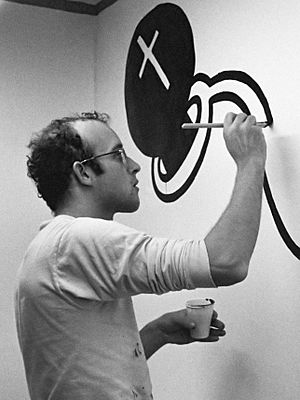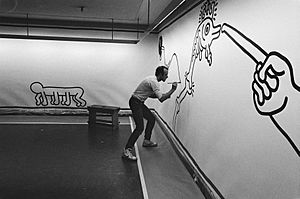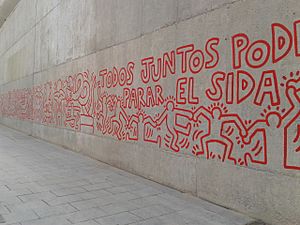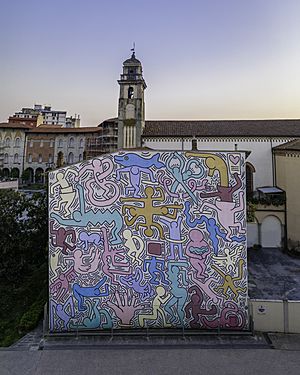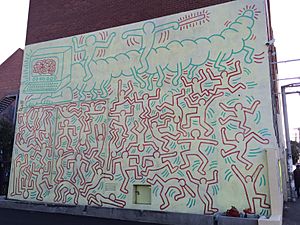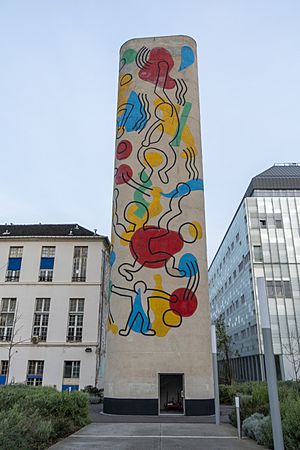Keith Haring facts for kids
Quick facts for kids
Keith Haring
|
|
|---|---|
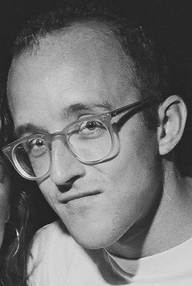
Haring in 1988
|
|
| Born |
Keith Allen Haring
May 4, 1958 Reading, Pennsylvania, U.S.
|
| Died | February 16, 1990 (aged 31) New York City, U.S.
|
| Education |
|
|
Notable work
|
|
| Movement | |
| Signature | |
 |
|
Keith Allen Haring (born May 4, 1958 – died February 16, 1990) was an American artist. He became famous for his pop art and street art in the 1980s. His lively drawings became a well-known visual language around the world.
Haring's art gained popularity from his quick drawings in the New York City Subway. He used chalk to draw figures, dogs, and other simple shapes on empty black ad spaces. After becoming known, he created large, colorful murals. Many of these were requested by others. Between 1982 and 1989, he made over 50 public artworks. Many were done for free for hospitals, day care centers, and schools.
In 1986, he opened the Pop Shop to share his art even more. His later work often showed important social messages. Haring died on February 16, 1990, due to complications from AIDS. He used his art to raise awareness about AIDS.
Contents
Keith Haring's Life Story
Early Life and School: 1958–1979
Keith Haring was born in Reading, Pennsylvania, on May 4, 1958. He grew up in Kutztown, Pennsylvania. His mother was Joan Haring, and his father, Allen Haring, was an engineer and cartoonist. Keith had three younger sisters: Kay, Karen, and Kristen.
He loved art from a very young age. He spent time drawing with his father. His early inspirations included Walt Disney cartoons, Dr. Seuss, Charles Schulz, and the The Bugs Bunny Show.
Haring studied commercial art from 1976 to 1978. He attended the Ivy School of Professional Art in Pittsburgh. But he soon wanted to focus on his own art. He was inspired by a book called The Art Spirit by Robert Henri.
He worked at the Pittsburgh Center for the Arts. This allowed him to explore art by famous artists like Jean Dubuffet and Jackson Pollock. He was also influenced by a 1977 art show of Pierre Alechinsky's work. A lecture by sculptor Christo in 1978 also inspired him. Alechinsky's art encouraged him to make large drawings with words and characters. Christo showed him ways to involve the public in his art.
Haring had his first big solo art show in Pittsburgh in 1978. Later that year, he moved to New York City to study painting at the School of Visual Arts. He also worked at a nightclub called Danceteria.
Early Art Work: 1980–1981
Haring first became known for his graffiti art in the subways. He used white chalk to draw on empty black ad spaces in subway stations. He called the subways his "laboratory." It was a place where he could try out new ideas and create art for free.
His most famous symbol became the "Radiant Baby." This is a crawling infant with rays of light coming from it. He used it as his signature on his subway art. Other symbols like barking dogs, flying saucers, and large hearts also became common in his work. His art quickly spread, and he became very recognizable.
In 1980, Haring started organizing art shows at Club 57. His friend and photographer Tseng Kwong Chi filmed these events. Haring had his first solo art show in February 1981 at Westbeth Painters Space. In November 1981, he had another solo show at Hal Bromm Gallery.
Becoming Famous: 1982–1986
In January 1982, Haring was one of the first artists to show work on a computer billboard in Times Square. That summer, he created his first large outdoor mural on the Houston Bowery Wall. In his paintings, he often used lines to show energy and movement. Haring worked very quickly, sometimes finishing 40 paintings in one day.
In 1982, Haring's art was shown at documenta 7 in Germany. His work was displayed alongside famous artists like Joseph Beuys and Andy Warhol. In October 1982, he had an exhibition with fellow graffiti artist Angel "LA II" Ortiz.
In February 1983, Haring had a solo show at the Fun Gallery. That year, he also participated in the São Paulo Art Biennial in Brazil and the Whitney Biennial in New York. In April 1983, he was asked to paint a mural called Construction Fence in Milwaukee.
Later in 1983, Haring painted a room at the Pittsburgh Center for the Arts. He also created an outdoor mural at PPG Place. In October 1983, fashion designer Elio Fiorucci invited Haring to Milan to paint the walls of his store. While in London, Haring met and began working with choreographer Bill T. Jones. Haring even painted Jones' body from head to toe!
Haring and Angel "LA II" Ortiz designed a T-shirt for the clothing brand WilliWear Productions in 1984. Fashion designer Vivienne Westwood also used Haring's drawings for her clothing collection. Haring's friend Madonna wore a skirt from this collection in her 1984 music video "Borderline."
Even as he became famous, Haring continued to draw in the subways. He enjoyed giving his art away for free. He often handed out free buttons and posters. In 1984, he released a book called Art in Transit. His quick rise to international fame was covered by the media. His art was on the cover of Vanity Fair in February 1984.
In 1984, the New York City Department of Sanitation asked Haring to design a logo for their anti-litter campaign. He also participated in the Venice Biennale. He was invited to create temporary murals in Australia. During his visit, he painted the permanent Keith Haring Mural in Melbourne. That year, Haring also painted murals in Minneapolis and Rio de Janeiro.
Haring designed a United Nations stamp in 1985. It celebrated International Youth Year. He also designed sets for MTV and painted murals for art places and nightclubs. In March 1985, Haring painted walls for the Biennale de Paris. In July 1985, he made a painting for the Live Aid concert in Philadelphia. He also designed "Free South Africa" posters in 1985. He created a poster for the 1986 Great Peace March for Global Nuclear Disarmament.
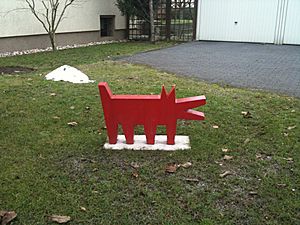
In the spring of 1986, Haring had his first solo museum show at the Stedelijk Museum Amsterdam. He also painted a mural there. In June 1986, Haring created a huge banner called CityKids Speak on Liberty. It celebrated the 100th anniversary of the Statue of Liberty. Later that month, he created a mural in East Harlem. The police first thought it was vandalism and arrested him. But after the news reported the story, he was released. This mural showed Haring's goal of raising awareness, not just selling art.
On October 23, 1986, Haring painted a mural on the Berlin Wall. It was 300 meters long. It showed red and black figures on a yellow background. These colors represented the German flag. They symbolized hope for unity between East and West Germany.
Haring also worked with Grace Jones. He painted her body for her music video "I'm Not Perfect" (1986). He also painted her for her role in the 1986 film Vamp. Haring designed album covers for artists like David Bowie and Sylvester.
Pop Shop: 1986
In April 1986, Haring opened the Pop Shop in Soho, New York. It sold shirts, posters, and other items with his artwork. This made his art available to many people at fair prices. Haring stopped drawing in the subways after opening the shop. He also stopped because people were taking his subway drawings and selling them.
Some people criticized Haring for selling his art. But Haring said, "My shop is an extension of what I was doing in the subway stations, breaking down the barriers between high and low art." The Pop Shop stayed open until 2005. The money earned went to the Keith Haring Foundation.
Haring wanted his art to be for everyone. He made art in subways and on billboards. His figures often had no clear age, race, or identity. This made his work relatable to many people. Around the time of the Pop Shop, his art began to show more social and political messages.
Later Years: 1987–1990
From 1982 to 1989, Haring had over 100 art shows. He created more than 50 public artworks for charities, hospitals, and schools.
In 1987, Haring had exhibitions in Helsinki and Paris. While in Paris, he painted the Tower mural. It was on an 88-foot-high stairwell at the Necker Children's Hospital. That same year, he painted a mural at the Museum of Contemporary Art, Antwerp in Belgium.
Haring also painted a mural at the Knokke Casino in Belgium. He designed a carousel for André Heller's Luna Luna. This was a temporary amusement park in Germany. In August 1987, Haring painted a large mural at the Carmine Street Recreation Center's outdoor pool in New York.
Haring designed the cover for the 1987 album A Very Special Christmas. The money from this album went to the Special Olympics.
Also in 1987, Haring painted the 'We the Youth' mural in Philadelphia. It celebrated the 200th anniversary of the United States Constitution. This mural is Haring's longest-standing public mural in its original spot.
In 1988, Haring opened Pop Shop Tokyo. In April 1988, he created a mural on the South Lawn for the White House Easter Egg Roll. He donated it to Children's National Hospital. In December 1988, Haring's exhibition opened at the Tony Shafrazi Gallery. He felt he had to prove himself because of his health.
In February 1989, Haring painted the Todos Juntos Podemos Parar el SIDA mural in Barcelona. It raised awareness about the AIDS epidemic. In May 1989, Haring visited Chicago. He painted a 480-foot mural in Grant Park with nearly 500 students.
For The Center Show, Haring painted his Once Upon a Time... mural in a men's bathroom at the Lesbian, Gay, Bisexual & Transgender Community Center. This celebrated the 20th anniversary of the Stonewall riots. In June 1989, Haring painted his Tuttomondo mural in Pisa, Italy.
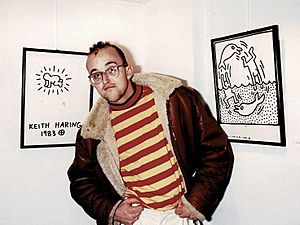
Haring used his art to talk about social issues like AIDS. He created a piece called Rebel with Many Causes (1989). It showed a theme of "hear no evil, see no evil, speak no evil." In November 1989, Haring painted a mural at the ArtCenter College of Design in California. It was for "A Day Without Art," an AIDS Awareness Day. He told the Los Angeles Times: "My life is my art, it's intertwined. When AIDS became a reality in terms of my life, it started becoming a subject in my paintings." In 1990, Haring painted a BMW Z1 car. He traveled to Paris for what would be his last exhibition in January 1990.
His Death
On February 16, 1990, Keith Haring died due to complications from AIDS. He passed away at his apartment in Greenwich Village, New York. He was cremated, and his ashes were scattered in a field near his hometown of Kutztown, Pennsylvania. Three months after his death, Haring appeared in a documentary film called Silence = Death. This film was about artists fighting for the rights of people with AIDS. It was released on May 4, which would have been his 32nd birthday.
Haring's Legacy
The Keith Haring Foundation
In 1989, Haring started the Keith Haring Foundation. Its goal is to provide money and art to AIDS organizations and children's programs. The foundation helps non-profit groups that teach young people and inform the public about HIV and AIDS. It also shares his artwork and information about his life. The foundation supports art and education by funding exhibitions and publications.
Awards and Tributes
To celebrate his life, Madonna announced that her 1990 Blond Ambition World Tour would have a benefit concert in Haring's memory. Over $300,000 from ticket sales was given to the Foundation for AIDS Research.
Haring's work was used in several projects by the Red Hot Organization. These projects raised money and awareness for AIDS. His art is still shown all over the world.
In 1991, Haring was honored on the AIDS Memorial Quilt. His famous baby icon was on a fabric panel. Haring's aunt and mother helped make it.
In 2008, a balloon honoring Haring was featured in the Macy's Thanksgiving Day Parade. On May 4, 2012, which would have been Haring's 54th birthday, Google honored him with a Google Doodle.
In 2014, Haring was one of the first people honored in the Rainbow Honor Walk in San Francisco. This "walk of fame" recognizes people who have made important contributions in their fields. In June 2019, Haring was one of the first 50 American "pioneers, trailblazers, and heroes" added to the National LGBTQ Wall of Honor. This wall is inside the Stonewall National Monument in New York City.
What Influenced Haring's Art
Haring was influenced by the work of William Burroughs and Brion Gysin. He was also inspired by other artists like Andy Warhol and Jean-Michel Basquiat.
The Three Mile Island accident, a nuclear power plant incident, greatly affected Haring. His fear of nuclear disaster began to appear in his art. For example, he made a black and white striped flag that he said symbolized the danger of a nuclear apocalypse.
Haring was deeply influenced by the Jesus Movement when he was young. This movement was a group of Christians known for their simple living and focus on helping the poor. Religious symbols and ideas from this movement appeared in his art throughout his career. He once said, "All that stuff stuck in my head and even now there are lots of religious images in my work."
When Haring drew graffiti in the subway, he used the "Radiant Baby" as his signature. This baby with radiating lines hinted at the Christ Child. He continued to create images of the Christ Child. His last artworks were two religious triptychs (three-panel paintings). They showed the Last Judgment.
Art Exhibitions
During his life, Haring had over 50 solo art shows. His work was shown by famous galleries like the Tony Shafrazi Gallery. Since his death, his art has been featured in over 150 exhibitions around the world. He has also been the subject of several large art shows that look back at his entire career.
Haring had his first solo exhibition in February 1981. That month, he also took part in the New York/New Wave exhibit at MoMA PS1. His breakthrough exhibition was at the Tony Shafrazi Gallery in 1982. That same year, his work was shown at documenta 7 in Germany. He also created art for a billboard in Times Square. In 1983, Haring's work was included in the Whitney Biennial and the São Paulo Biennial.
In 1984, Haring participated in the group show Arte di Frontiera: New York Graffiti in Italy. He also took part in the Venice Biennale in 1984 and 1986. In 1985, an exhibition of his works opened in Bordeaux, France. In 1986, three of Haring's sculptures were placed near the Headquarters of the United Nations.
In 1996, a major exhibition of his work was held at the Museum of Contemporary Art Australia. In 1997, the Whitney Museum of American Art in New York held a large show of his art. At the same time, some of his outdoor sculptures were displayed in Central Park.
In 2008, there was a large exhibition of his art in Lyon, France. In February 2010, the Tony Shafrazi Gallery showed dozens of his works. In March 2012, a show called Keith Haring: 1978–1982 opened at the Brooklyn Museum. In April 2013, Keith Haring: The Political Line opened in Paris. It then moved to the De Young Museum in San Francisco in November 2014.
From December 2016 to June 2017, the Petersen Automotive Museum in Los Angeles showed The Unconventional Canvases of Keith Haring. This exhibit featured five vehicles that Haring had painted. In 2019, the first major UK exhibition of Haring's work was at Tate Liverpool. From December 2019 to March 2020, the National Gallery of Victoria in Melbourne showed Keith Haring and Jean-Michel Basquiat: Crossing Lines.
In February 2021, the Museum of Contemporary Art Denver opened an exhibition called Keith Haring: Grace House Mural. It showed 13 panels from a mural Haring painted at a Catholic youth center in the 1980s. The mural was originally 85 feet long. When the building was sold, parts of the mural were cut out and sold at auction. These panels are now on loan to the museum.
Art Market and Collections
In October 1982, a news report showed Haring's solo exhibit at the Tony Shafrazi Gallery. It was reported that over $250,000 worth of paintings were sold in just a few days. Even though he was a known artist by 1983, Haring wanted to keep his prices low. His prices ranged from $3,000 for a drawing to $15,000 for a large painting. By 1984, his works were selling for up to $20,000.
Haring created the Pop Shop in 1986. It sold T-shirts, toys, and posters with his art. This made his works available to more people. Haring once said about the Pop Shop: "My shop is an extension of what I was doing in the subway stations, breaking down the barriers between high and low art."
After his death in 1990, the Keith Haring Foundation took care of his art and legacy. In May 2017, Haring's painting Untitled (1982) sold for $6.5 million at an auction. This made it the most expensive Haring artwork sold at auction at that time.
In October 2020, the Keith Haring Foundation held an online auction of over 140 works from Haring's collection. All the money from the sale went to the Lesbian, Gay, Bisexual & Transgender Community Center of New York. In December 2021, Haring's 1982 painting Untitled (Acrobats) sold for $5.5 million.
Haring's work is in many important art collections. These include the Museum of Modern Art and the Whitney Museum of American Art in New York City. His art is also in the Los Angeles County Museum of Art and the Art Institute of Chicago. He also created many public artworks. These include a mural at Children's Village in New York and a room in the Lesbian, Gay, Bisexual & Transgender Community Center in Manhattan.
The Nakamura Keith Haring Collection opened in Japan in 2007. It is an art museum that only shows Haring's artworks.
Images for kids
-
Barking dog sculpture by Haring in Dortmund, Germany
-
Haring at his last exhibition at Galerie 1900-2000/La Galerie de Poche in Paris on January 15, 1990.
See also
 In Spanish: Keith Haring para niños
In Spanish: Keith Haring para niños


